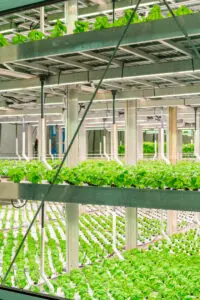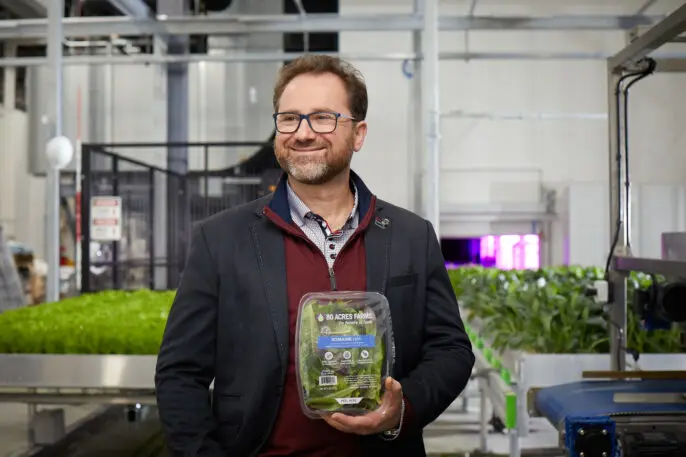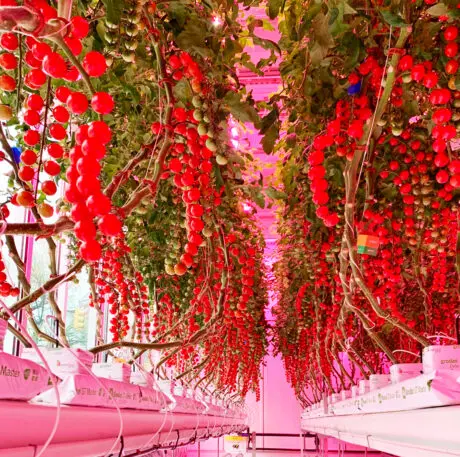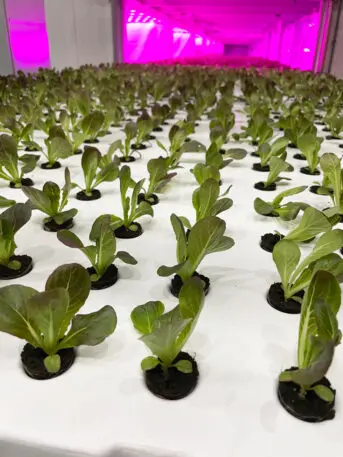Do you know how far the produce in your fridge has traveled to get to your house? I just checked: My rocket mix came from Mexico, my blueberries came from Peru, and my red grapes came from California.
The fact that my fridge feels more foreign than domestic is just how it is these days—if you buy your produce at large grocery stores, at least. Lettuce grown in California’s San Joaquin Valley will travel about 1,400 miles to reach supermarkets in Des Moines, Iowa. And grapes from Chile will travel over 7,000 miles—on a ship, then a truck—to reach the same destination.


Tisha Livingston and Mike Zelkind started 80 Acres Farms in 2015, with a single vertical farm in a small facility outside Cincinnati that could produce 80 acres’s worth of fruits and vegetables. Since then, the company has grown to eight farms, most of them in Ohio. Every farm uses 97% less water than traditional farming, since the crops grow without soil, rain, or sunlight. 80 Acres Farms doesn’t use pesticides or GMOs, and their farms run entirely on renewable energy.


For now, 80 Acres Farms only services its immediate region. “We scale hyper-locally,” says Zelkind. For a few months at the start of the pandemic, 80 Acres Farms installed a pop-up tomato farm outside the Guggenheim Museum in Manhattan (as a supplement to a pandemic-shuttered exhibition dedicated to the countryside). Growing in a pink-lit shipping container on the plaza, about 3,000 tomatoes were harvested every Wednesday and donated to New York City’s largest food rescue organization, City Harvest.
“Food-supply chains today are very good, but they’re optimized for one variable, and that variable is cost,” says Zelkind. “We can get food almost anywhere, but you don’t get nutrition to a lot of these neighborhoods.” (The company uses automation, robotics, and machine learning to help monitor every stage of growth, as well as light, water, nutrients, and air flow needed to produce nutritious food.)

The entire process, from harvesting to the moment it hits the shelves, takes about 48 hours. Part of that is because of the company’s local distribution, but also every stage of the business, from seeding to harvesting and packaging, fits under one roof. “We’re selling a highly perishable product, and the faster we can get it to consumers, the fresher and more nutritious it is, and the longer it lasts in consumers’ homes,” explains Zelkind.
For now, 80 Acres grows salad blends, microgreens, tomatoes, and herbs. Zoe Plakias, an assistant professor of agricultural, environmental, and development economics at The Ohio State University, explains that none of these products are grown at scale in Ohio, where food policy is more focused on commodity crops like corn and soybeans. “If you’re a consumer in Ohio going to Kroger, you’re getting your fresh produce from elsewhere, not Ohio,” she says.

The partnership contributes to Kroger’s Zero Hunger-Zero Waste initiative, which aims to end hunger in local communities and eliminate waste, company-wide, by 2025. It has already decreased the amount of food waste produced by stores by over 7% (that’s over 90 million pounds of food saved.)
There’s something else, too, and it’s the fact that local food is valued more highly. “There’s economic evidence that consumers will pay a higher price for foods they know are produced locally,” says Plakias. “This creates incentives for growers to produce for local markets and for retailers to sell locally produced goods.” (That’s not to say that growing locally is necessarily cheaper.)
Ultimately, there are environmental benefits to producing for local markets, but for Plakias, it all depends on how the resources are used, what is being grown, and what it’s replacing in consumers’ shopping baskets. “Something produced locally is not necessarily produced sustainably,” she says. “All food production is local to someone.”
In the case of 80 Acres Farms, produce is local only to the Midwest, and it will remain so until the company expands its footprint (where it goes next remains unclear, though locations will be driven by market research.) “If we built farms 10 times as big as our reference model, we still wouldn’t be making a dent in consumer demand for fresh food,” says Zelkind. “What we can do is build farms in every community, making local produce accessible year-round to everyone.”
Recognize your brand’s excellence by applying to this year’s Brands That Matter Awards before the early-rate deadline, May 3.
